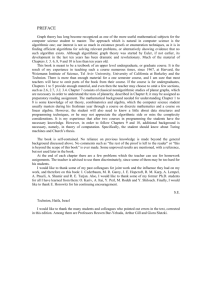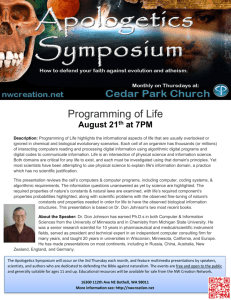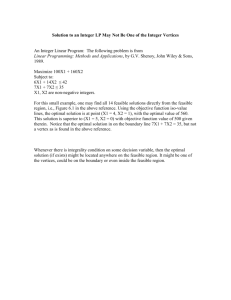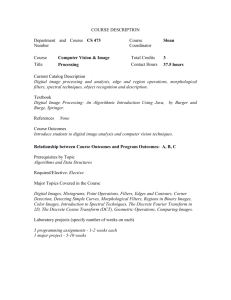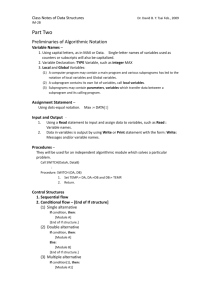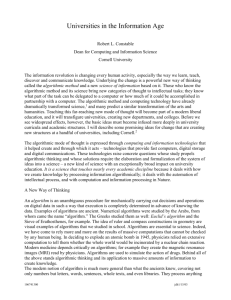x 2 - Technion moodle
advertisement
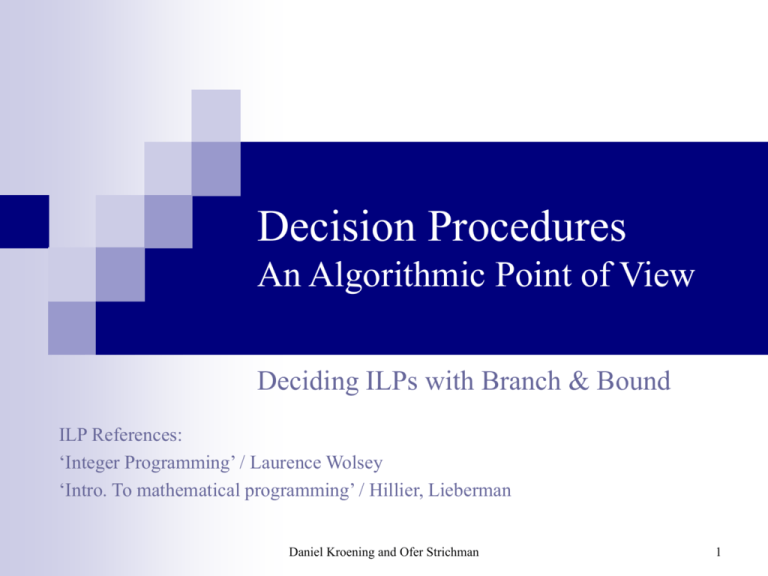
Decision Procedures
An Algorithmic Point of View
Deciding ILPs with Branch & Bound
ILP References:
‘Integer Programming’ / Laurence Wolsey
‘Intro. To mathematical programming’ / Hillier, Lieberman
Daniel Kroening and Ofer Strichman
1
We will see…
Solving a linear (continues) system
Good old Gaussian Elimination for linear equations.
Feasibility test a-la Simplex for linear inequalities.
Fourier-Motzkin for linear inequalities.
Solving a linear (discrete) system
Branch and Bound for integer linear inequalities.
The Omega-Test method for integer linear inequalities.
2
Decision Procedures - An algorithmic point of view
Integer Linear Programming
Problem formulation
max cx
Ax · b
x2Z
Where A is an m £ n coefficients matrix
x an n - dimensional column vector of variables.
b an m - dimensional column vector
3
Decision Procedures - An algorithmic point of view
Feasibility of a linear system
The decision problem associated with ILP is NP-hard.
But once again… we are not actually interested in ILP: we do
not have an objective…
All we want to know is whether a given system is feasible.
Ax · b
x2 Z
Still, NP-hard…
4
Decision Procedures - An algorithmic point of view
How different can it be from LP ?
Rounding cannot help!
LP Solution
Objective line
x2
Feasible region
x1
Integer Solution
5
Decision Procedures - An algorithmic point of view
How different can it be from LP ?
The LP problem can be feasible, whereas its ILP version is not.
x2
Feasible region
x1
6
Decision Procedures - An algorithmic point of view
A naïve solution strategy
From hereon we will assume that all variables are finite.
Enumerate all solutions with a tree
x1=0
x1=1
x2=0
x2=1 tox2find
=2 ax2feasible
=0
x2=1solution
x2=2
Guaranteed
x1=2
x2=1
ifxit2=0exists
x2=2
But, exponential growth in the size of the tree / computation
time
7
Decision Procedures - An algorithmic point of view
A family of algorithms: Branch & Bound
Probably the most popular method for solving Integer Linear
Programming (ILP) problems (First presented in 1960) is B &
B.
That is, the optimization problem.
Recall, however, that we are interested in deciding feasibility
of a linear system.
In practice that’s a little easier. The algorithm is quite similar.
8
Decision Procedures - An algorithmic point of view
Branch and Bound
The main idea:
Solve the ‘relaxed’ problem, i.e. no integrality constraints.
If the relaxed problem is infeasible – backtrack (there is no integer
solution in this branch)
If the solution is integral – terminate (‘feasible’).
Otherwise split on a variable for which the assignment is non-integral,
and repeat for each case.
More details to come…
9
Decision Procedures - An algorithmic point of view
Splitting on non-integral LP solutions.
Solve LP Relaxation to get fractional solutions
Create two sub-branches by adding constraints
Feasible real solution
x2
x2
x2≥2
x2≤1
x1
x1
10
Decision Procedures - An algorithmic point of view
Example
Suppose our system A has variables x1… x4, and that the LP
solver returned a solution (1, 0.7, 2.5, 3).
Choose one of x2, x3. Suppose we choose x2.
Solve two new problems:
A1 = A [ {x2 · 0}
A2 = A [ {x2 ¸ 1}
Clearly A1 or A2 are satisfiable iff A is.
11
Decision Procedures - An algorithmic point of view
Splitting on non-integral LP solutions.
The linear relaxation can also be infeasible…
…which prunes the search for an integral solution.
Feasible real solution
This branch is not feasible
x2≥3
x2
x2
x2≤2
x1
x1
12
Decision Procedures - An algorithmic point of view
The branch and bound tree
A
x2 · 0
x2 ¸ 1
(1,-1.5,1.5,4.1) A2
A1 (1,3,0.5,2)
x3 · 0
Pruned due to
infeasibility
(1,0 .7,2.5,3)
(1,3,0.5,2) A12
x3 ¸ 1
A11 (1,3,4,1)
x
Sub trees can be pruned away before reaching a leaf…
Each leaf is a feasible solution.
13
Decision Procedures - An algorithmic point of view
Aside: B & B for optimality
More reasons to prune the search.
In a maximality problem:
Prune a branch if an over-approximation of the largest solution under
this branch is still smaller than an under-approximation of the solution
in another branch.
If the solution at the node is integral, update lower bound on the
optimal solution, and backtrack.
14
Decision Procedures - An algorithmic point of view
Termination
Does B & B guaranteed to terminate ?
No.
Well, not in the way we presented it, anyway.
Consider a constraint like y + 0.1 · x · y + 0.2
y
x
15
Decision Procedures - An algorithmic point of view
Termination
The constraint y + 0.1 · x · y + 0.2 has
no integral solution, but
an unbounded real solution space.
We need a way to bound the search space.
16
Decision Procedures - An algorithmic point of view
Bounds
Let S be the input integer linear system with coefficient matrix A of
size M £ N and constants vector b.
If there is a solution, there is a solution x0 bounded as follows:
where µ is the maximal element in the coefficient matrix A or the
vector b.
17
Decision Procedures - An algorithmic point of view
Preprocessing (LP)…
Constraints can be removed…
Example:
x1 + x2 · 2, x1 · 1, x2 · 1
First constraint is redundant.
In general, for a set:
is redundant if
18
Decision Procedures - An algorithmic point of view
Preprocessing (LP)…
…and bounds can be tightened…
Example:
2x1 + x2 · 2,
x2 ¸ 4, x1 · 3
From 1st and 2nd constraints: x1 · -1
In general, if a0 > 0
And, if a0 < 0
19
Decision Procedures - An algorithmic point of view
Preprocessing (ILP)
Clearly
Consider a 0-1 ILP constraint:5x1 – 3x2 · 4
x1 = 1 implies x2 = 1
Hence, we can add x1 · x2
(Again, a 0-1 ILP problem) Combine pairs:
from x1 + x2 · 1 and x2 ¸ 1 conclude x1 = 0;
More simplifications and preprocessing is possible…
The rule is: preprocess as long as it is cost-effective.
20
Decision Procedures - An algorithmic point of view
Improvement - Cutting Planes
Eliminate non-integer solutions by adding constraints to LP
(i.e. improve tightness of relaxation).
x2
All feasible integer
solutions remain feasible
Current LP solution is not
feasible
x1
Added Cut
21
Decision Procedures - An algorithmic point of view
Cutting planes
Adding valid inequalities
Examples:
1.
x1, x2 , x3 ,x4 2 B
From x1 – x2 + x3 – x4 · -1
… we can conclude x2 + x4 ¸ 1
2.
x2 Z
From 2x · 11
…we can conclude x · 5
22
Decision Procedures - An algorithmic point of view

